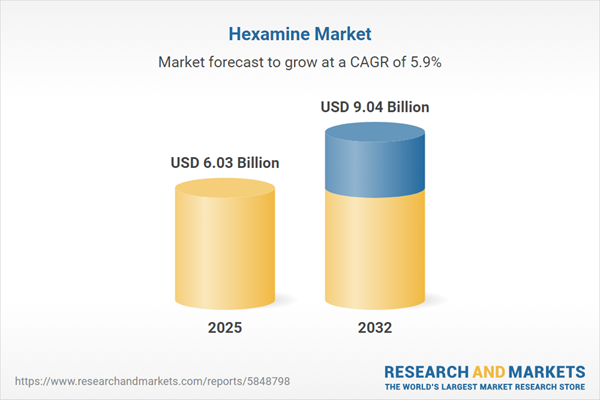Speak directly to the analyst to clarify any post sales queries you may have.
Senior executives navigating the complexities of the hexamine market will find this overview designed for rapid decision-making. The following analysis distills current industry dynamics, regulatory drivers, and key operational challenges impacting growth, with a focus on strategic resilience and forward planning.
Market Snapshot: Hexamine Market Growth and Outlook
The global hexamine market demonstrates robust momentum, projected to expand from USD 5.69 billion in 2024 to USD 6.03 billion in 2025. By 2032, forecasts place its valuation at USD 9.04 billion, representing a CAGR of 5.94%. This sustained growth comes as manufacturers and suppliers respond to widening application areas, the rise of stricter environmental protocols, and new technology deployments. Companies are prioritizing innovation, process optimization, and supply chain modernization to remain competitive amid shifting regulatory and sustainability demands. Strategic adjustments to business models and operations reflect an industry-wide shift toward both efficiency and compliance.
Scope & Segmentation of the Hexamine Market
This report delivers a granular analysis of the hexamine market, supporting executive teams in critical growth and risk planning. Coverage spans the key segments and trends most relevant to market leadership:
- Application: Covers use in food preservation, fuel tablets for military and outdoor applications, and smokeless fuel manufacturing to improve shelf life and safety across industries.
- End Use: Addresses hexamine contributions in crop protection, soil enhancement, animal feed production, antiseptic and preservative roles in personal care, and essential usage in the pharmaceutical sector across diverse formulation types.
- Form: Includes a full range of material formats: crystals, granules, powders, and tablets, enabling tailored process integration and operational efficiency across verticals.
- Grade: Details on analytical, pharmaceutical, reagent, and technical grades, clarifying alignment with specific compliance, quality, and performance benchmarks in end-user industries.
- Regional Coverage: Encompasses the Americas (U.S., Canada, Brazil, Mexico, Argentina) and Asia-Pacific economies (China, India, Japan), as well as major European, Middle Eastern, and African markets, with a focus on countries like the UK, Germany, and France.
- Companies Profiled: Features leading organizations such as Eastman Chemical Company, BASF SE, Arkema S.A., and additional market leaders recognized for advancing product portfolios and driving regional adaptation.
- Technological and Sustainability Trends: Examines uptake of advanced synthesis and purification technologies, increased digital supply chain implementation, a move toward bio-based inputs, and circular economy investments guided by evolving environmental mandates.
Key Takeaways for Senior Decision-Makers
- Hexamine’s adaptable profile promotes product innovation and positions companies to quickly align offerings with evolving regulatory or sector needs.
- Heightened regulatory expectations are compelling a shift toward greener sourcing strategies and optimizing procurement frameworks on a global scale.
- Companies using digital supply chain tools are achieving better operational transparency, allowing them to respond more efficiently to disruptions while aligning with sustainability targets.
- Segment-specific flexibility in product form and grade empowers organizations to address regional compliance requirements and niche market needs more effectively.
- Asia-Pacific distinctive market traits support rapid growth and increased investment, while the Americas and EMEA regions emphasize stability, resilience, and consistent regulatory compliance.
- Executives establishing collaborations and prioritizing sustainable practices are setting a benchmark for productivity and competitive positioning within their segments.
Tariff Impact on Global Supply Chains
Recent tariff implementations in the United States are prompting firms operating in the hexamine industry to evaluate sourcing approaches and strengthen supplier networks. Many respond by investing in domestic production capacity and diversifying international supply channels to reduce volatility, protect margins, and ensure uninterrupted procurement for key regional markets.
Methodology & Data Sources
This study employs a mixed-methods methodology, combining subject matter expert interviews, stakeholder consultations, and systematic reviews of industry literature and regulatory records. Triangulated findings ensure executive-focused, reliable insights supporting top-level planning.
Why This Report Matters
- Clarifies the forces shaping the hexamine sector, including new regulatory frameworks, technology updates, and sustainability priorities affecting manufacturers worldwide.
- Enables senior leaders to recalibrate product development, optimize supply chains, and build tailored expansion strategies to address specific operational environments.
- Guides risk anticipation efforts in response to international tariffs, sustainability standards, and evolving capital deployment priorities within supply and procurement chains.
Conclusion
This report equips executive leadership with essential, data-driven perspectives, helping organizations proactively respond to industry change and enhance capabilities in the competitive hexamine market landscape.
Additional Product Information:
- Purchase of this report includes 1 year online access with quarterly updates.
- This report can be updated on request. Please contact our Customer Experience team using the Ask a Question widget on our website.
Table of Contents
3. Executive Summary
4. Market Overview
7. Cumulative Impact of Artificial Intelligence 2025
Samples

LOADING...
Companies Mentioned
The key companies profiled in this Hexamine market report include:- Eastman Chemical Company
- Nouryon Chemicals B.V.
- Merck KGaA
- Solvay S.A.
- BASF SE
- Arkema S.A.
- Huntsman Corporation
- Ashland Global Holdings Inc.
- LANXESS AG
- Evonik Industries AG
Table Information
| Report Attribute | Details |
|---|---|
| No. of Pages | 191 |
| Published | October 2025 |
| Forecast Period | 2025 - 2032 |
| Estimated Market Value ( USD | $ 6.03 Billion |
| Forecasted Market Value ( USD | $ 9.04 Billion |
| Compound Annual Growth Rate | 5.9% |
| Regions Covered | Global |
| No. of Companies Mentioned | 11 |









